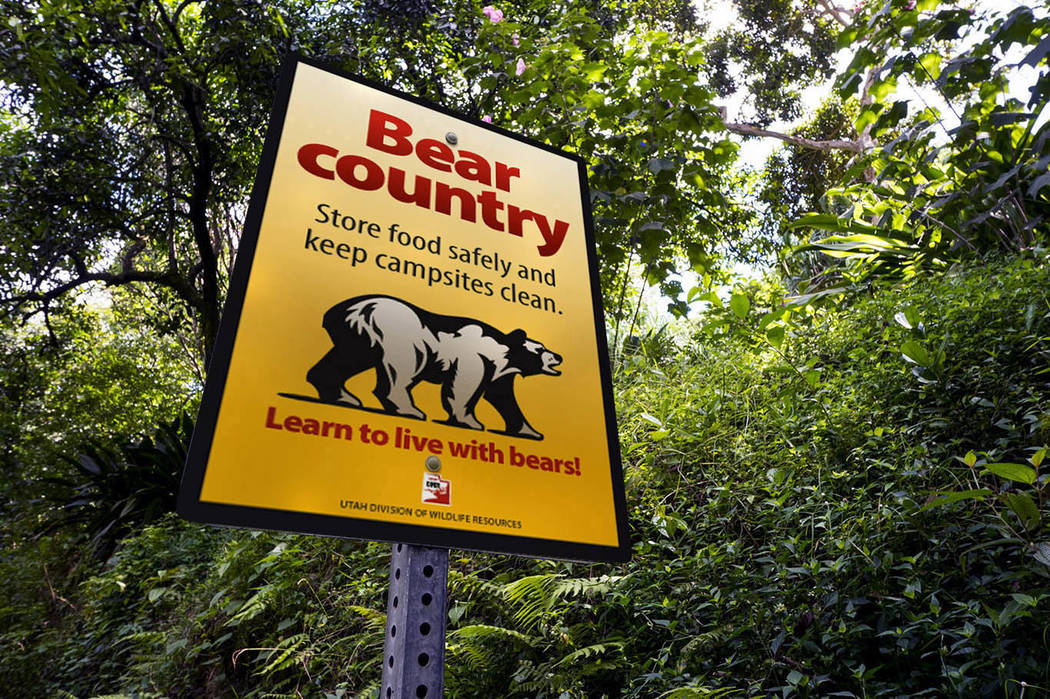Preparation key to preventing encounters with bears
Late summer and early fall are great times to enjoy the outdoors, especially at higher elevations where cooling temperatures are a welcome relief from the heat and leaves can begin their annual color change in late August.
When the scrub oak begins its seasonal transition from green to red, it means that hunting season is a few weeks away and the time has come to get one’s gear ready.
Then there is the sound of yellow quaking aspen leaves shimmering in the fall breeze. Few things can be more enjoyable than sitting quietly by a campfire and listening to the sounds those leaves make as they rattle in the wind.
Outdoor enthusiasts also stand a good chance of seeing a variety of wildlife because they all are busy getting ready for winter. Primarily, that means putting on the fat that will help to carry them through the winter. This is true across Nevada, even in Clark County.
While we often tend to think in terms of such species as deer or elk, we sometimes forget that there are other species living in the high country. Among those is the black bear. In Nevada, the black bear population is located along the Sierra Nevada Front near Reno and Carson City far from Las Vegas, but in neighboring states, bears are widely scattered.
Parts of Utah and northern Arizona that are popular with Southern Nevadans also are popular with black bears.
As with other animals, bears also spend late summer and early fall putting on weight before winter temperatures arrive and they head to their den for a long winter’s nap. So anyone planning to camp, hunt or otherwise spend time in bear country should keep that in mind and plan accordingly. Preparation can help to prevent an unpleasant bear encounter.
They don’t happen frequently, but they do happen.
A 13-year-old camper learned that firsthand as he slept on the ground with other members of his group at the Dewey Bridge Campground along the Colorado River near the town of Moab, Utah, a popular destination for outdoor enthusiasts. The young man was awakened rather abruptly about 5:45 a.m. Aug. 9 when a black bear bit him on his left cheek and ear.
According to the Utah Division of Wildlife Resources, whose officers responded to the scene, the boy was taken to the emergency room in Moab before being transported to a hospital in Grand Junction, Colorado, where he was treated and released. The family asked for privacy and told DWR officials they didn’t want to talk with the media.
After the attack, the Bureau of Land Management closed the campground. Personnel from the DWR and the U.S. Department of Agriculture Wildlife Services located bear tracks in the area and began tracking the animal. At about 6:30 that evening, investigators found the bear within a mile of the campground where the attack occurred.
The bear “matched the size, color and tracks of the bear involved in the incident. The bear also matched photos taken of a bear in the same area earlier in the week,” the DWR said in a news release.
“The majority of the time, we relocate black bears when there are nuisance situations where a black bear is getting into trash or food,” DWR mammals coordinator Darren DeBloois said. “We primarily euthanize when it is a matter of public safety.”
For that reason, the bear in this case was euthanized. The BLM reopened the campground Monday.
One of the keys for preventing bear issues in the wild is keeping a clean camp. The DWR website says that bears have a good memory and will return to any location where they have found food. Never store food in your tent. Not even an empty wrapper. Instead use a bear-proof container if available, your vehicle or a tree. Dispose of trash in bear-proof dumpsters, wipe down your table and clean your cooking equipment.
It also pays to keep your eyes open for signs of bear activity and adjust your plans as needed. A few preventative steps can save you, future visitors and a bear.
Freelance writer Doug Nielsen is a conservation educator for the Nevada Department of Wildlife. His “In the Outdoors” column, published Thursday in the Las Vegas Review-Journal, is not affiliated with or endorsed by the department. Any opinions are his own. Find him on Facebook at @dougwritesoutdoors. He can be reached at intheoutdoorslv@gmail.com.





























